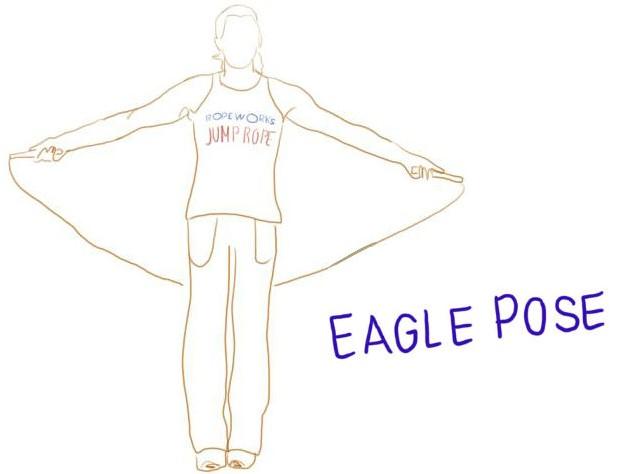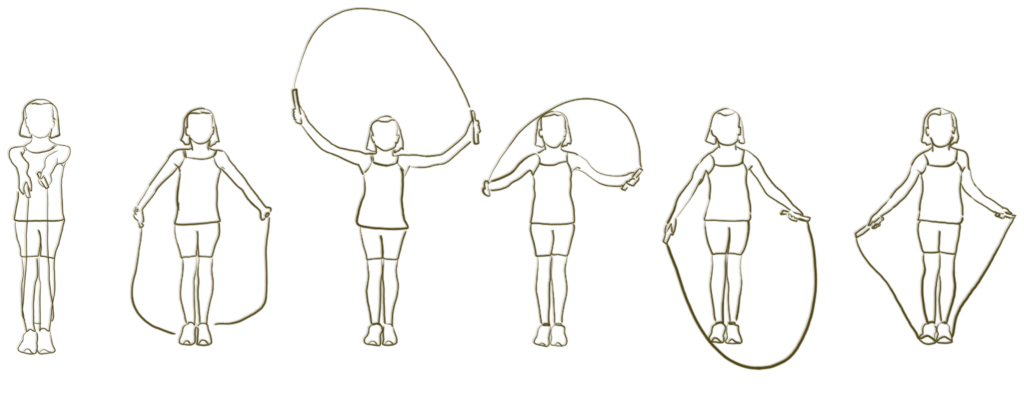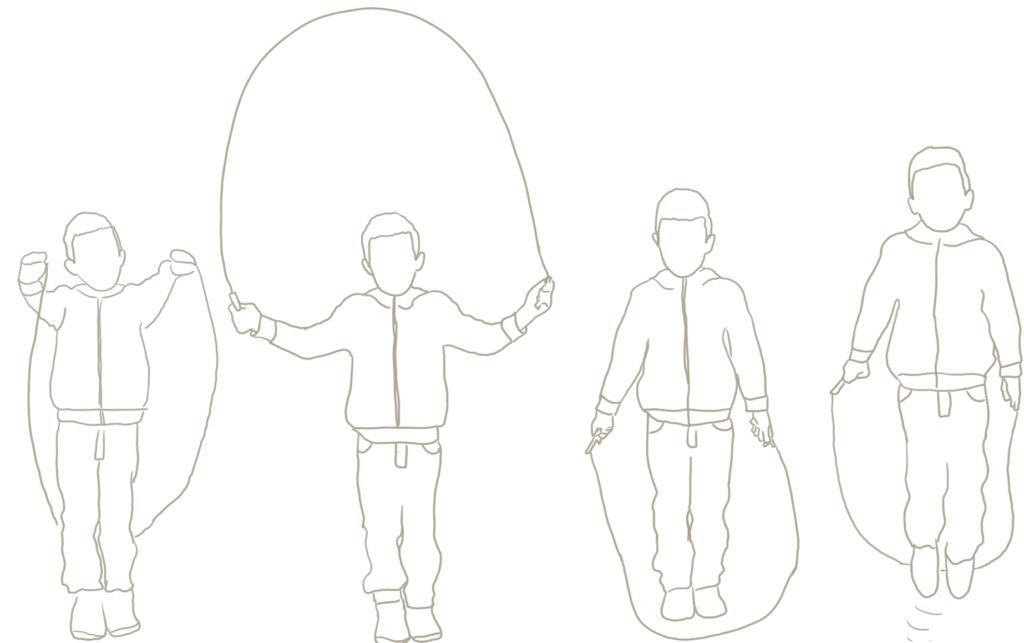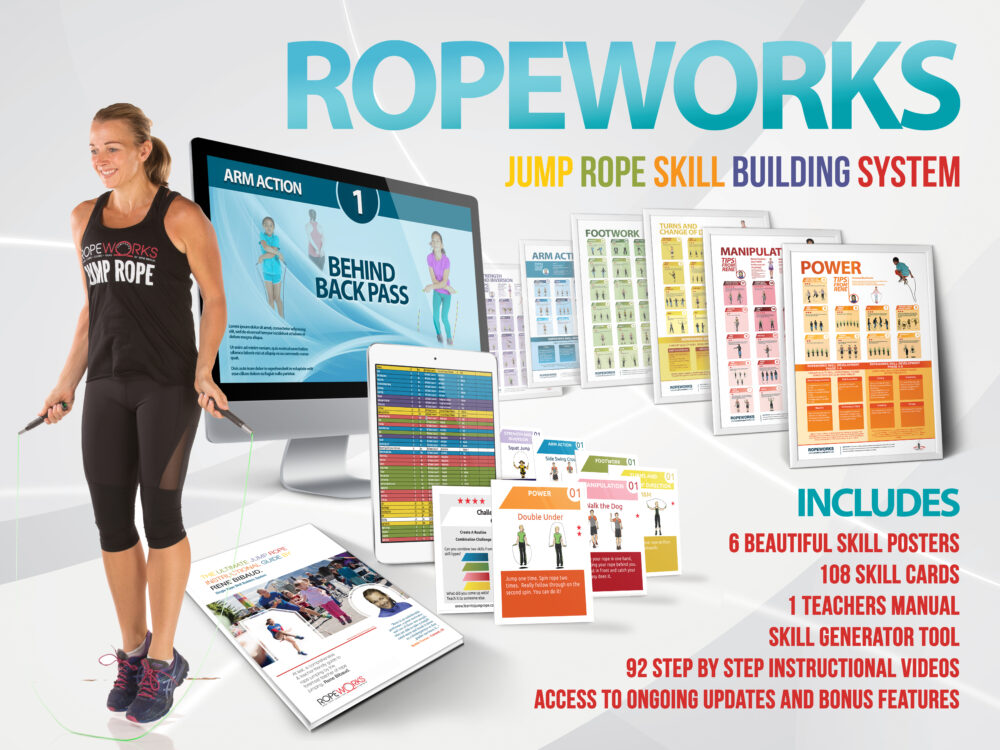Lesson Plans
&
Skill Builders for "jump Online"
PERSONAL BEST:
- Practice helps us improve over time.
- Personal best is a goal setting activity that helps athletes focus on small incremental improvements over time and give focus to each individual's unique goals.
How It Works:
- When Coach says “go” start jumping rope.
- Count the number of jumps you can do before you make a mistake.
- When you do miss, make a mental note of the number of completed jumps and wait for the other class members to finish.
- Every time you go again you’ll try to beat your overall best score.
- Practice this at home and track your score. See if you can beat your score at least one time per week.
JUMP ROPE JAM:
Jump rope jam is a chance to show what you have been working on, want to show, or a skill you have mastered. Perfection is not required, rather, a willingness to try and show something. When you are done showing your skill, take a bow and wave so we know you are finished.
SKILL BUILDERS:
Recognizing our differences, our strengths, weaknesses and developing a growth mind-set is at the core of approach to skill development. We open classes to athletes of all skill levels and work hard to find appropriate challenges for all students. When kids learn to focus on self improvement and avoid comparing to others, real growth can happen. As you take a look at each of our skill sets below, you’ll see a wide range of levels of difficulty. We will help your child identify the best phase to work on and encourage them to move on when ready, or keep practicing to develop more confidence. In time, we help your child develop more independence in determining this on their own. There is never a rush to move down the list and we remind participants that there’s great value in developing confidence at each phase of learning. (mastery) Each skill segment is designed so that a room of students can be focused on one type of move together, while still differentiating for each individual. This allows each student to find appropriate goals in the process of skill development.
CLASS DATES AND TIMES:
Mondays: 2:00-2:40PM March 30 - May 4th
Tuesdays: 2:00-2:40PM April 7 - May 5th
Wednesdays: 1:30-2:05PM,2:30-3:05PM April 1 - June 10th
Fridays: 2:00-2:40PM April 10 - May 8th
Be ready to go before you log in with the following suggestions:
- Please tie your hair back, avoid distractions like siblings and loud televisions or animals.
- Make sure the camera is set up to show full body.
- Wear athletic clothing and avoid skirts items of clothing that "move' when you jump.
- Have Foundation Checklist available.
The following is a general daily timeline
- :-10 minutes before class - Log in, get set-up and adjust your settings.
- :00 Class Start Time - Quick "hello" and get started with our "Foundation Builder" drills.
- :10 - Skill Builders - work on one Skill Builder sequence with Coach Rene checking in and making suggestions with each student.
- :20 - Jump Rope Jam
- :25 New Skill Builder Sequence with Coach Rene checking in and making suggestions with each student.
- :35 - Jump Rope Jam
- :37 - Personal Best
- :40 - Final words and suggestions for "optional homework"
SEE ACTIVITY DESCRIPTIONS to learn about Personal Best and Jump Rope Jam.
SEE WEEKLY SKILL BUILDER SCHEDULE to see which skills we will be working on and then click on it's respective Skill Builder tab below to see the skills broken down. (optional)
Every Class begins with Foundation Builders. Each participant will then be given various challenges. The following is the general schedule of planned challenges each week. Plan varies as needed.
Week Of March 30th:
Foundation Builders
M&M Sequence
Jogging Step
Rope Snap (not shown)
Week of April 6:
Walk the Dog
Jacks
Rocker N Roll
Week of April 13:
Cross Combos
Arm X Pose
The "One Foot"
Week of April 20:
Double It Up
Fruit Loop Fun
Week of April 27
Side Swing Crosses
Review of favorites
Footwork Moves
Week of May 4
Skill Review
A Lesson in the Art of Jumping Rope
Getting Started
Jumping rope requires patience and practice to develop coordination. Start simple, keep bouts short and add in skills to increase engagement.
Here’s how to get started.
The Set Up
Shoes
Wear athletic shoes such as cross training or running shoes that provide support.
Surface
Jump on an athletic surface such as a sport court or hard wood floor. Adults should avoid jumping on hard or concrete surfaces. At home piece of plywood sized 4×6 or so can turn any spot into a jump rope platform.
General Sizing & Buying Guide:
- Ages 4-5 = 7′ Rope
- Elementary = 8′ Rope
- 5’7-5’10 = 9′ Rope
- 5’11 and taller = 10′ Rope
Types of Ropes
- Licorice speed ropes are the most common and affordable and most versatile rope. Perfect for elementary through high school P.E.
- Long Handled Freestyle ropes provides an extra long handle for performing skills with more ease. These are more costly and better for individual use.
- Wire Ropes are used for speed and double unders.
- Beaded Ropes are used for anything really. I use them for Double Dutch and Partner Routines such as Wheel, Shared Rope and Buddy Jumping
Adjusting Your Rope – Tie Some Knots
Some ropes come with an adjustable function inside of the handle. These adjustments are really meant to be done one time. Adjusting over and over will compromise the component.
 During the learning phase of rope jumping, focus primarily on learning the rhythm and timing of rope jumping. As your coordination improves, focusing on your posture, rope hold and rope spin will help you become more efficient and proficient.
During the learning phase of rope jumping, focus primarily on learning the rhythm and timing of rope jumping. As your coordination improves, focusing on your posture, rope hold and rope spin will help you become more efficient and proficient.
Keep your hands in just below your hips. This will make your rope feel longer. Ever so slightly, shrug your shoulders.
- If you rope feels too long or is hitting the ground too much, adjust the length. The rope should barely graze the ground, right in front of your toes.
- Position your elbows back BEHIND your body and your wrists angled down toward the ground.
- Spin the rope mostly with your wrists. Doing so will take practice.
- Only bend legs slightly to absorb the shock of your landing. Avoid kicking your heels back, or picking forward.
- Jump on your toes, only jumping high enough to clear the rope. Heels should not touch the ground when you land.
- In order to jump low to the ground, you’ll need to spin your rope fast. Turn small quick circles with your wrists, just below your waist.
- Try to jump at least 130 beats per minute (every time you jump counts as a beat)
Build Coordination, Fitness and Timing, Over Time.
Very short bouts of proper rope jumping will yield faster results and better technique if you commit to a regular routine of jumping rope. During any workout routine, whether it be weight training or cardio training, try any of these training suggestions:
Personal Best:
How long can you jump rope without breaking form or losing speed? Stop, rest and repeat. Try and beat your score. Repeat one more time. That’s it. Come back in a day and try again.
10 and 10:
Jump for 10, rest 10 seconds. Do this 10 times.
Skill Development:
Work on your basic bounce for 30 seconds. Then rest.
Work through learning a new skill. Rest as much as needed.
As you can see, the point is not lengthy bouts of jump rope. The initial phase should be moderately challenging and fun with focus on developing your timing and technique.
Patience and Practice
Rope jumping requires coordination and timing. The only way to improve is through regular practice. Early on you’ll make a lot of mistakes. It’s OK! Focus on effort and enjoyment, not results. Through regular short sessions over time, your results will follow.
Beginning Learning Phases For Young & Beginner Jumpers:
1. Eagle:
Rope behind you, arms extended out, down and low. Thumbs follow the handle of the rope and point toward the rope. (check younger jumpers to assure proper grip)

2. Ready Position:
Start here before doing anything.
From “Eagle Pose” reach arms straight out in front of you. Tug on the back of your legs with the rope. Always start in ready position.

5. Bunny Jump
Initially, very young jumpers (4-6) will typically progress from “Swing, WAIT, Jump” to this jumping style. The rope will spin slowly and taking resting bounces between each spin of the rope. Once your young jumper can perform 20 “Bunny Jumps” in a row, progress to the “Basic Bounce” (see video above)
3. Swing & Stop:
From ready position, swing your rope over your head, and stop it in front of you. No jumping. Swing it back over the other way and continue doing so until it feels easy and smooth. Next try “Swing, Wait, Jump”.
4. Swing, Wait, Jump
One swing, wait for the rope to hit the ground. Then jump over it while keeping arms relaxed (no whipping motion required)

Skills How-To (Rotating Gallery)
Our instructional videos are formatted to get you off to jumping as quickly as possible. The format starts with a full size view of the skill, at regular and slow motion. Then we break the skill down and finish with suggestions for next steps where applicable.
I also like to include short routines and ideas to spark creativity and new ideas.
Check back for a rotating gallery of skills. You may also purchase the entire library of 92 videos through our Skill Builders System.
Get it ALL
Our Skill Builder System gives unlimited access to 92 jump rope skills from basic through intermediate level skills.

Foundation Builders

Jacks Skill Builders

M&M Sequence coming soon

Jogging Step - Step by Step Coming Soon

Walk the Dog Sequence coming soon

One Arm Forward Swing Sequences coming soon
Sequence coming soon - Coach

Double It Up
Sequence coming soon - Coach

The One Foot
Sequence coming soon - Coach

Fruit Loop Fun
Sequence coming soon

Rocker N Roll
Sequence coming soon

Arm X
Sequence coming soon

Cross Combos
Sequence coming soon
